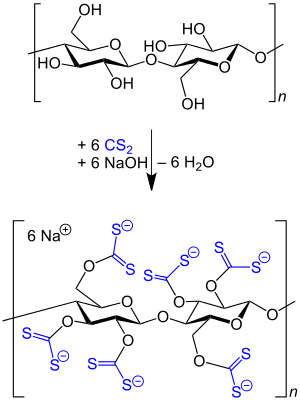Regenerated cellulose
Regenerated cellulose is a class of materials manufactured by the conversion of natural cellulose to a soluble cellulosic derivative and subsequent regeneration, typically forming either a fiber (via polymer spinning) or a film (via polymer casting).[1]

History
George Audemars first manufactured regenerated nitrocellulose fibers in 1855.[2] Though these fibers were soft and strong -resembling silk- they had the drawback of being highly flammable. Hilaire de Chardonnet perfected production of nitrocellulose fibers, but manufacturing of these fibers was relatively uneconomical.[2] In 1890, L.H. Despeissis invented the cuprammonium process -which uses a cuprammonium solution to solubilize cellulose- a method still used today for production of artificial silk.[3] In 1891, it was discovered that treatment of cellulose with alkali and carbon disulfide generated a soluble cellulose derivative known as viscose.[2] This process, patented by the founders of the Viscose Development Company, is the most widely used method for manufacturing regenerated cellulose products. Courtaulds purchased the patents for this process in 1904, leading to significant growth of viscose fiber production.[4] By 1931, expiration of patents for the viscose process led to its adoption worldwide. Global production of regenerated cellulose fiber peaked in 1973 at 3,856,000 tons.[2]
Applications
Regenerated cellulose can be used to manufacture a wide variety of products. While the first application of regenerated cellulose was as a clothing textile, this class of materials is also used in the production of disposable medical devices as well as fabrication of artificial membranes.[4]
See also
References
- ↑ Alger, Mark (1996). Polymer science dictionary (2nd ed.). London: Chapman & Hall. ISBN 0412608707.
- 1 2 3 4 Abetz, Volker (2005). Encyclopedia of polymer science and technology (Wird aktualisiert. ed.). [Hoboken, N.J.]: Wiley-Interscience. ISBN 9780471440260.
- ↑ Woodings, Calvin (2001). Regenerated cellulose fibres. [Manchester]: The Textile Institute. ISBN 9781855734593.
- 1 2 Borbély, Éva (2008). "Lyocell, the New Generation of Regenerated Cellulose". Acta Polytechnica Hungarica. 5 (3).